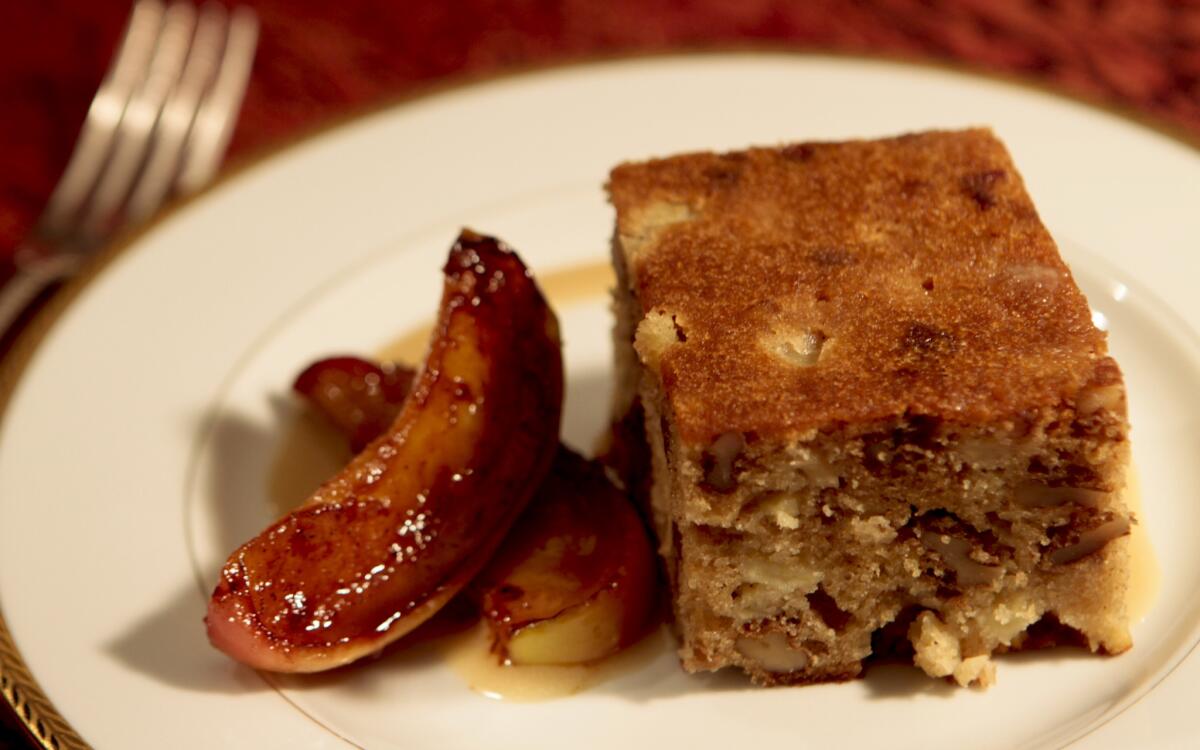Apple date honey cake

It seems like Rosh Hashanah customs were created by lovers of fruits and vegetables. Most families will begin Sunday night’s holiday dinner with apple wedges dipped in honey to symbolize the hope for a sweet new year, and many serve sweet vegetables, especially carrots and sweet potatoes.
We like the Sephardi custom of starting the meal with a mini-Seder, a ritual derived from the Talmud. Guests sample small portions of certain vegetables and fruits, such as pumpkin, leeks, chard, black-eyed peas, pomegranate seeds and dates, and say a blessing with each one. The choices vary depending on what’s available at the market -- pumpkin might be replaced by other squashes, black-eyed peas by other beans, and chard by beet leaves or spinach.
And the blessings vary depending on the community and individual home. Some blessings have roots in Talmudic symbolism. Pomegranate seeds are served because they stand for the wish that one’s mitzvot, or good deeds, be as numerous as the fruit’s seeds, which are said to be 613, the same as the number of commandments in the Torah.
Other blessings are actually puns on the Hebrew or Aramaic names of the foods. The word for black-eyed peas, for example, sounds like the word for increase, and therefore the blessing is “may our merits increase.”
To make the blessings more meaningful, some create puns based on the language spoken in their home. Suggestions for English speakers include eating peas as a hope for peace. Some of these have quite different meanings than in other languages. When eating dates, the traditional saying “may our enemies be destroyed,” based on the Hebrew word for date, could be replaced by wishing single friends “happy dating.”
Because of the emphasis on sweetness for Rosh Hashanah, some avoid lemon juice and other sour ingredients and sharp foods like chiles. There are those who don’t even eat nuts because the Hebrew words for “nut” and for “sin” have the same numerological value.
One of our favorite Jewish New Year customs, observed on the second day of the holiday, calls for eating an exotic fruit or one that has just come into season and reciting a blessing that expresses gratitude for having lived to this joyous day. We enjoy sampling several fruits, such as fresh yellow dates that have turned honey-brown, Asian pears, Keitt mangoes, dragonfruit, lychees or even durian. But the fruits over which we recite this blessing most enthusiastically are fresh figs, preferably from our garden.
Heat the oven to 350 degrees. Lightly grease a 9-inch square pan, line it with parchment paper or waxed paper and grease the paper.
Sift the flour with the baking powder, baking soda, cinnamon and cloves into a medium bowl.
In a small bowl, combine 1 tablespoon of the oil with the diced dates and rub gently to separate them. Add the chopped walnuts and toss lightly with a fork to keep dates in separate pieces.
Peel and core the apples and slice them about one-eighth-inch thick. Cut the slices into one-fourth to one-third-inch pieces.
In the bowl of a stand mixer, or in a large bowl using an electric mixer, beat the eggs lightly. Add the white and brown sugars and beat until smooth. Beat in the honey. Beat at high speed until the mixture is smooth and lightened in color, about 3 minutes. Gradually beat in the remaining oil at low speed until blended.
With a wooden spoon, stir in the flour mixture alternately with applesauce, each in two batches. Add the lemon zest and mix it in thoroughly. Stir in the apple pieces and the date and walnut mixture, mixing them in thoroughly.
Pour the batter into the prepared pan. Bake until a cake tester inserted in the center of the cake comes out clean, 35 to 50 minutes.
Cool the cake in the pan for 15 minutes. Turn it out onto a rack and carefully peel off the paper and set aside to cool completely. Tightly cover the cooled cake until needed.
Serve the cake at room temperature as squares or bars. If serving it with sauce and garnish, spoon 2 teaspoons sauce on the plate alongside each piece of cake and add 2 apple wedges. Serve any remaining sauce separately.
Get our Cooking newsletter.
Your roundup of inspiring recipes and kitchen tricks.
You may occasionally receive promotional content from the Los Angeles Times.















